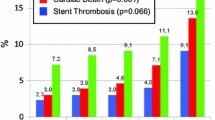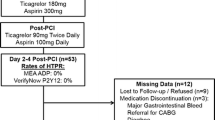Abstract
In vitro “high post-treatment platelet reactivity” (HPPR) measured with light transmittance aggregometry (LTA) and the VerifyNow P2Y12 assay has been associated with an increased risk of ischemic events after percutaneous coronary intervention (PCI). However, there are many criteria for HPPR according to the methods used for assessment, and correlations among suggested criteria have not been evaluated. To this end, we enrolled 1,058 unselected patients undergoing PCI in real clinical practice, simultaneously assessed platelet measures with LTA (both 5 and 20 μmol/l ADP-induced) and the VerifyNow P2Y12 assay, and based on previous studies, evaluated the following criteria for HPPR: 5 or 20 μmol/l ADP-induced maximal platelet reactivity (PRmax) ≥50%; 5 μmol/l ADP-induced late PR (PRlate) >14%; 20 μmol/l ADP-induced PRmax ≥62%; and P2Y12 reaction unit (PRU) ≥240. Receiver-operating characteristics (ROC) curve analysis demonstrated that PRU (cut-off = 241) distinguished between patients with and without 5 μmol/l ADP-induced PRmax ≥50% (area under curve [AUC] 0.822, sensitivity 83.0%, specificity 66.0%, P < 0.001), and 20 μmol/l ADP-induced PRmax ≥62% (AUC 0.840, sensitivity 80.7%, specificity 71.4%, P < 0.001), respectively. PRU ≥240 showed a moderate agreement with 5 μmol/l ADP-induced PRmax ≥50% (κ = 0.438, concordant rate 71.6%, P < 0.001) and 20 μmol/l ADP-induced PRmax ≥62% (κ = 0.505, concordant rate 75.1%, P < 0.001). Cut-offs matched for 20 μmol/l ADP-induced PRmax ≥50% (PRU = 195) and 5 μmol/l ADP-induced PRlate >14 (PRU = 194) also were similar. The presence of significant correlations between the suggested criteria for HPPR has practical implications on the possible use of the VerifyNow P2Y12 assay for risk stratification in PCI-treated patients.



Similar content being viewed by others
References
Mehta SR, Yusuf S, Peters RJ, Bertrand ME, Lewis BS, Natarajan MK, Malmberg K, Rupprecht H, Zhao F, Chrolavicius S, Copland I, Fox KA, Clopidogrel in Unstable Angina to Prevent Recurrent Events (CURE) Trial Investigators (2001) Effects of pretreatment with clopidogrel and aspirin followed by long-term therapy in patients undergoing percutaneous coronary intervention: the PCI-CURE study. Lancet 358:527–533
Steinhubl SR, Berger PB, Mann JT III, Fry ET, DeLago A, Wilmer C, Topol EJ; CREDO Investigators. Clopidogrel for the Reduction of Events During Observation (2002) Early and sustained dual oral antiplatelet therapy following percutaneous coronary intervention: a randomized controlled trial. JAMA 288:2411–2420
Angiolillo DJ, Fernandez-Ortiz A, Bernardo E, Alfonso F, Macaya C, Bass TA, Costa MA (2007) Variability in individual responsiveness to clopidogrel: clinical implications, management, and future perspectives. J Am Coll Cardiol 49:1505–1516
Gurbel PA, Bliden KP, Hiatt BL, O’Connor CM (2003) Clopidogrel for coronary stenting: response variability, drug resistance, and the effect of pretreatment platelet reactivity. Circulation 107:2908–2913
Bliden KP, DiChiara J, Tantry US, Bassi AK, Chaganti SK, Gurbel PA (2007) Increased risk in patients with high platelet aggregation receiving chronic clopidogrel therapy undergoing percutaneous coronary intervention: Is the current antiplatelet therapy adequate? J Am Coll Cardiol 49:657–666
Buonamici P, Marcucci R, Migliorini A, Gensini GF, Santini A, Paniccia R, Moschi G, Gori AM, Abbate R, Antoniucci D (2007) Impact of platelet reactivity after clopidogrel administration on drug-eluting stent thrombosis. J Am Coll Cardiol 49:2312–2317
Cuisset T, Frere C, Quilici J, Barbou F, Morange PE, Hovasse T, Bonnet JL, Alessi MC (2006) High post-treatment platelet reactivity identified low-responders to dual antiplatelet therapy at increased risk of recurrent cardiovascular events after stenting for acute coronary syndrome. J Thromb Haemost 4:542–549
Gurbel PA, Bliden KP, Guyer K, Cho PW, Zaman KA, Kreutz RP, Bassi AK, Tantry US (2005) Platelet reactivity in patients and recurrent events post-stenting: results of the PREPARE POST-STENTING study. J Am Coll Cardiol 46:1820–1826
Hochholzer W, Trenk D, Bestehorn HP, Fischer B, Valina CM, Ferenc M, Gick M, Caputo A, Büttner HJ, Neumann FJ (2006) Impact of the degree of peri-interventional platelet inhibition after loading with clopidogrel on early clinical outcome of elective coronary stent placement. J Am Coll Cardiol 48:1742–1750
Trenk D, Hochholzer W, Fromm MF, Chialda LE, Pahl A, Valina CM, Stratz C, Schmiebusch P, Bestehorn HP, Büttner HJ, Neumann FJ (2008) Cytochrome P450 2C19 681G>A polymorphism and high on-clopidogrel platelet reactivity associated with adverse 1-year clinical outcome of elective percutaneous coronary intervention with drug-eluting or bare-metal stents. J Am Coll Cardiol 51:1925–1934
Marcucci R, Gori AM, Paniccia R, Giusti B, Valente S, Giglioli C, Buonamici P, Antoniucci D, Abbate R, Gensini GF (2009) Cardiovascular death and nonfatal myocardial infarction in acute coronary syndrome patients receiving coronary stenting are predicted by residual platelet reactivity to ADP detected by a point-of-care assay: a 12-month follow-up. Circulation 119:237–242
Patti G, Nusca A, Mangiacapra F, Gatto L, D’Ambrosio A, Di Sciascio G (2008) Point-of-care measurement of clopidogrel responsiveness predicts clinical outcome in patients undergoing percutaneous coronary intervention results of the ARMYDA-PRO (Antiplatelet therapy for Reduction of MYocardial Damage during Angioplasty-Platelet Reactivity Predicts Outcome) study. J Am Coll Cardiol 52:1128–1133
Price MJ, Endemann S, Gollapudi RR, Valencia R, Stinis CT, Levisay JP, Ernst A, Sawhney NS, Schatz RA, Teirstein PS (2008) Prognostic significance of post-clopidogrel platelet reactivity assessed by a point-of-care assay on thrombotic events after drug-eluting stent implantation. Eur Heart J 29:992–1000
Valgimigli M, Campo G, de Cesare N, Meliga E, Vranckx P, Furgieri A, Angiolillo DJ, Sabatè M, Hamon M, Repetto A, Colangelo S, Brugaletta S, Parrinello G, Percoco G, Ferrari R, Tailoring Treatment with Tirofiban in Patients Showing Resistance to Aspirin and/or Resistance to Clopidogrel (3T/2R) Investigators (2009) Intensifying platelet inhibition with tirofiban in poor responders to aspirin, clopidogrel, or both agents undergoing elective coronary intervention: results from the double-blind, prospective, randomized Tailoring Treatment with Tirofiban in Patients Showing Resistance to Aspirin and/or Resistance to Clopidogrel study. Circulation 119:3215–3222
Breet NJ, van Werkum JW, Bouman HJ, Kelder JC, Ruven HJ, Bal ET, Deneer VH, Harmsze AM, van der Heyden JA, Rensing BJ, Suttorp MJ, Hackeng CM, ten Berg JM (2010) Comparison of platelet function tests in predicting clinical outcome in patients undergoing coronary stent implantation. JAMA 303:754–762
Jeong YH, Kim IS, Choi BR, Kwak CH, Hwang JY (2008) The optimal threshold of high post-treatment platelet reactivity could be defined by a point-of-care VerifyNow P2Y12 assay. Eur Heart J 29:2186–2187
van Werkum JW, van der Stelt CA, Seesing TH, Hackeng CM, ten Berg JM (2006) A head-to-head comparison between the VerifyNow P2Y12 assay and light transmittance aggregometry for monitoring the individual platelet response to clopidogrel in patients undergoing elective percutaneous coronary intervention. J Thromb Haemost 4:2516–2518
von Beckerath N, Pogatsa-Murray G, Wieczorek A, Sibbing D, Schomig A, Kastrati A (2006) Correlation of a new point-of-care test with conventional optical aggregometry for the assessment of clopidogrel responsiveness. Thromb Haemost 95:910–911
Angiolillo DJ, Bernardo E, Sabaté M, Jimenez-Quevedo P, Costa MA, Palazuelos J, Hernández-Antolin R, Moreno R, Escaned J, Alfonso F, Bañuelos C, Guzman LA, Bass TA, Macaya C, Fernandez-Ortiz A (2007) Impact of platelet reactivity on cardiovascular outcomes in patients with type 2 diabetes mellitus and coronary artery disease. J Am Coll Cardiol 50:1541–1547
Angiolillo DJ, Shoemaker SB, Desai B, Yuan H, Charlton RK, Bernardo E, Zenni MM, Guzman LA, Bass TA, Costa MA (2007) Randomized comparison of a high clopidogrel maintenance dose in patients with diabetes mellitus and coronary artery disease: results of the Optimizing Antiplatelet Therapy in Diabetes Mellitus (OPTIMUS) study. Circulation 115:708–716
Harrison P, Frelinger AL III, Furman MI, Michelson AD (2007) Measuring antiplatelet drug effects in the laboratory. Thromb Res 120:323–336
Bhatt DL, Topol EJ (2003) Scientific and therapeutic advances in antiplatelet therapy. Nat Rev Drug Discov 2:15–28
Jakubowski JA, Payne CD, Li YG, Brandt JT, Small DS, Farid NA, Salazar DE, Winters KJ (2008) The use of the VerifyNow P2Y12 point-of-care device to monitor platelet function across a range of P2Y12 inhibition levels following prasugrel and clopidogrel administration. Thromb Haemost 99:409–415
Lordkipanidze M, Pharand C, Nguyen TA, Schampaert E, Palisaitis DA, Diodati JG (2008) Comparison of four tests to assess inhibition of platelet function by clopidogrel in stable coronary artery disease patients. Eur Heart J 29:2877–2885
Lordkipanidze M, Pharand C, Nguyen TA, Schampaert E, Diodati JG (2008) Assessment of VerifyNow P2Y12 assay accuracy in evaluating clopidogrel-induced platelet inhibition. Ther Drug Monit 30:372–378
Malinin A, Pokov A, Spergling M, Defranco A, Schwartz K, Schwartz D, Mahmud E, Atar D, Serebruany V (2007) Monitoring platelet inhibition after clopidogrel with the VerifyNow-P2Y12(R) rapid analyzer: the VERIfy Thrombosis risk ASsessment (VERITAS) study. Thromb Res 119:277–284
Varenhorst C, James S, Erlinge D, Braun OO, Brandt JT, Winters KJ, Jakubowski JA, Olofsson S, Wallentin L, Siegbahn A (2009) Assessment of P2Y(12) inhibition with the point-of-care device VerifyNow P2Y12 in patients treated with prasugrel or clopidogrel coadministered with aspirin. Am Heart J 157:562.e1–e9
Gurbel PA, Becker RC, Mann KG, Steinhubl SR, Michelson AD (2007) Platelet function monitoring in patients with coronary artery disease. J Am Coll Cardiol 50:1822–1834
Gurbel PA, Bliden KP, Samara W, Yoho JA, Hayes K, Fissha MZ, Tantry US (2005) Clopidogrel effect on platelet reactivity in patients with stent thrombosis: results of the CREST study. J Am Coll Cardiol 46:1827–1832
Kim IS, Choi BR, Jeong YH, Kwak CH, Kim S (2009) The CYP2C19*2 and CYP2C19*3 polymorphisms are associated with high post-treatment platelet reactivity in Asian patients with acute coronary syndrome. J Thromb Haemost 7:897–899
Lee JM, Park S, Shin DJ, Choi D, Shim CY, Ko YG, Kim JS, Shin ES, Chang CW, Lee JE, Jang Y (2009) Relation of genetic polymorphisms in the cytochrome P450 gene with clopidogrel resistance after drug-eluting stent implantation in Koreans. Am J Cardiol 104:46–51
Acknowledgments
This study was partly supported by grants from the Research Foundation of Gyeongsang National University Hospital and Gyeongsang Institute of the Life Science. The authors thank Roberto Patarca for proofreading and for his words of encouragement.
Conflict of interest
Dr Jeong YH has received honoraria for lectures from Sanofi-Aventis, Daiichi Sankyo Inc, and Otsuka.
Author information
Authors and Affiliations
Corresponding author
Rights and permissions
About this article
Cite this article
Kim, IS., Jeong, YH., Kang, MK. et al. Correlation of high post-treatment platelet reactivity assessed by light transmittance aggregometry and the VerifyNow P2Y12 assay. J Thromb Thrombolysis 30, 486–495 (2010). https://doi.org/10.1007/s11239-010-0484-2
Published:
Issue Date:
DOI: https://doi.org/10.1007/s11239-010-0484-2




